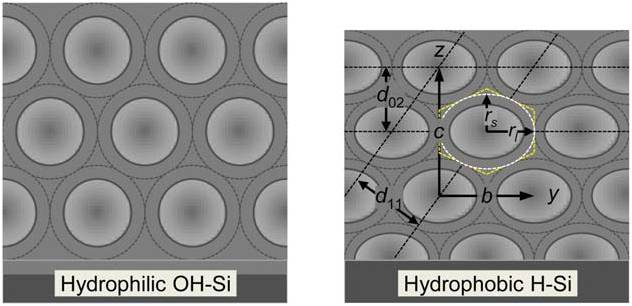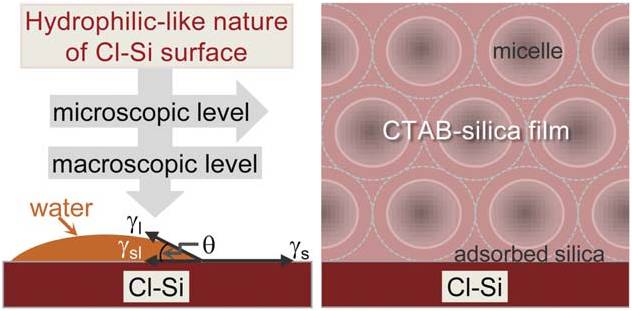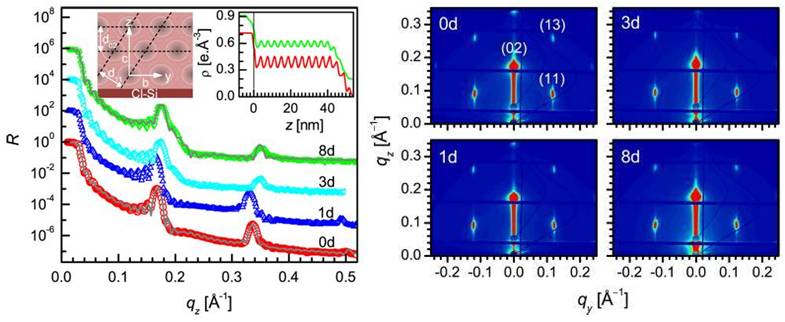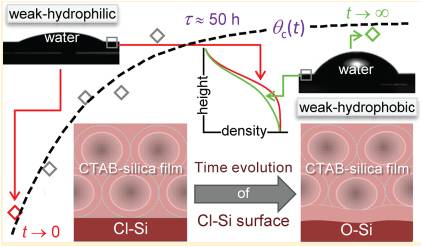Nature of Cl-passivated Si surface and its evolution with time
Silicon is perhaps the most widely investigated semiconductor material due to its various uses in device fabrication. Among different investigations, one of the thrust areas is tuning the nature of the Si surface to control the growth and stability of different interesting nanostructures on it. Tuning the nature of the surface can be done through the termination or passivation of the Si dangling bonds with selective atoms or groups, which essentially modifies the surface free energy, the polar/nonpolar (hydrophilic/hydrophobic) or electrostatic nature, the reactivity of the surface and also prevents contamination and surface defect states, thus controlling the electronic properties of the surface or interface. Understanding the nature (hydrophilic-hydrophobic) of a passivated Si surface and its stability is very important for its proper utilization.  The nature of a surface is well evident from the growth of amphiphilic molecules or composite materials having both hydrophilic and hydrophobic parts, apart from conventional contact angle (CA) or water adhesion measurements. For the CTAB-silica (organic-inorganic) mesostructured film, hydrophilic silica molecules are adsorbed on the OH-Si surface to form a silica layer (gray color), while the hydrophobic tail parts of the CTAB molecules are adsorbed on the H-Si surface to form hemicircular micelles (light color), as presented schematically. Accordingly, the near circular micelles on the former became less circular (or more elliptical) on the latter (light color). It is clear that the hydrophilic/hydrophobic nature of a solid surface, on the microscopic level, can be evident from the structural information of the deposited film. The nature of a surface is well evident from the growth of amphiphilic molecules or composite materials having both hydrophilic and hydrophobic parts, apart from conventional contact angle (CA) or water adhesion measurements. For the CTAB-silica (organic-inorganic) mesostructured film, hydrophilic silica molecules are adsorbed on the OH-Si surface to form a silica layer (gray color), while the hydrophobic tail parts of the CTAB molecules are adsorbed on the H-Si surface to form hemicircular micelles (light color), as presented schematically. Accordingly, the near circular micelles on the former became less circular (or more elliptical) on the latter (light color). It is clear that the hydrophilic/hydrophobic nature of a solid surface, on the microscopic level, can be evident from the structural information of the deposited film.
The hydrophilic/hydrophobic nature of a Cl-terminated Si surface, which is slightly controversial, was investigated on the molecular level by depositing CTAB-silica 2D-hexagonal mesostructured films on it as well as on OH- and H-terminated Si surfaces and determining their structures by combining X-ray reflectivity (XR) and grazing incidence small angle X-ray scattering (GISAXS) measurements.  The CA measurements, which provide macroscopic level information, confirm that the Cl-Si surface is hydrophilic in nature but less hydrophilic than the OH-Si surface. The initial attachment of a film (through a silica layer) and the (near circular) shape of the micelles, which provide microscopic level information, clearly indicate that the Cl-Si surface is hydrophilic in nature and its hydrophilicity is comparable to that of the OH-Si surface. The relatively strong electronegativity of Cl is probably the reason for the hydrophilic nature of the Cl-Si surface, while the lack of hydrogen bonding and/or the lack of complete chlorination are a hindrance [published in Soft Matter 9, 9799 (2013)]. The CA measurements, which provide macroscopic level information, confirm that the Cl-Si surface is hydrophilic in nature but less hydrophilic than the OH-Si surface. The initial attachment of a film (through a silica layer) and the (near circular) shape of the micelles, which provide microscopic level information, clearly indicate that the Cl-Si surface is hydrophilic in nature and its hydrophilicity is comparable to that of the OH-Si surface. The relatively strong electronegativity of Cl is probably the reason for the hydrophilic nature of the Cl-Si surface, while the lack of hydrogen bonding and/or the lack of complete chlorination are a hindrance [published in Soft Matter 9, 9799 (2013)].
The stability of Cl-terminated Si surface at ambient conditions and its evolution with time, which have immense importance for the growth of interesting nanostructures on it, were investigated using complementary methods. Wetting of water, i.e., CA measurements, which provide macroscopic level information, shows transition in the nature of Cl-Si surface from weak-hydrophilic toward weak-hydrophobic with time. Wetting of water, i.e., CA measurements, which provide macroscopic level information, shows transition in the nature of Cl-Si surface from weak-hydrophilic toward weak-hydrophobic with time.  Electron density profiles, obtained from XR measurements, suggest that such a transition is associated with the growth of less uniform oxide layer. Structures of CTAB-silica mesostructured films on as-prepared and time-evolved Cl-Si substrates, obtained from XR and GISAXS measurements, show transition from strongly attached near circular micelles to weakly attached more elliptical micelles, confirming the transition (from weak-hydrophilic toward weak-hydrophobic) in microscopic level and growth of less homogeneous oxide layer. The critical time of such a transition is about 50 h, which actually represents the stability or the critical time of Cl desorption and oxide growth of the Cl-Si surface at ambient conditions. [published in J. Phys. Chem. C 118, 11350 (2014)]. Electron density profiles, obtained from XR measurements, suggest that such a transition is associated with the growth of less uniform oxide layer. Structures of CTAB-silica mesostructured films on as-prepared and time-evolved Cl-Si substrates, obtained from XR and GISAXS measurements, show transition from strongly attached near circular micelles to weakly attached more elliptical micelles, confirming the transition (from weak-hydrophilic toward weak-hydrophobic) in microscopic level and growth of less homogeneous oxide layer. The critical time of such a transition is about 50 h, which actually represents the stability or the critical time of Cl desorption and oxide growth of the Cl-Si surface at ambient conditions. [published in J. Phys. Chem. C 118, 11350 (2014)].
|

